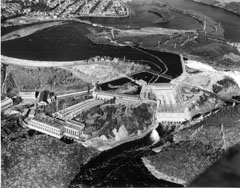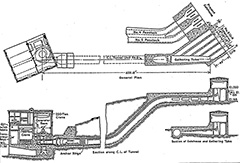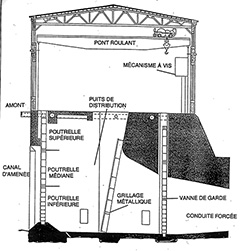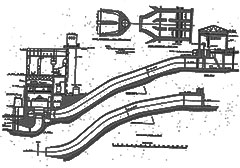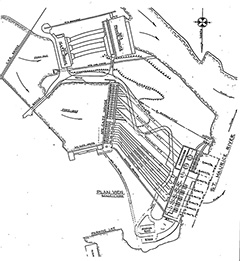Home > How It Works > Hydroelectric Production > Hydropower Generating Station
Hydropower Generating Station
A hydropower generating station is made up of several components, all necessary for the production of electricity. The availability of a head, meaning the difference in elevation between a point upstream of the generating station and a point downstream, is essential; otherwise, electricity cannot be produced. Therefore, the first step consists of building a water intake and penstocks to channel the water to the turbine located below. It is also always advantageous to build a dam to create a reservoir upstream of the water intake. In addition to increasing the head and, therefore the quantity of energy produced by the same volume of water, the reservoir can store water for days and seasons, which can then be used on the basis of the varying demand for electricity.
Thus, a hydropower generating station is made up of several components including a reservoir, a dam, a headrace, a water intake, a penstock and, of course, a station where the turbines and generators are installed.
Retaining Structures
The flow of a river generally varies a great deal during the year. In the spring, with the snowmelt, rivers contain much more water than in the dead of summer or the middle of winter, when water accumulates as snow. Therefore, it is very important to manage the natural flow of rivers to adjust them to the demand for electricity. This is achieved through a reservoir containing millions of cubic metres of water in order to be able to respond to the demand for electricity all year long.
Some reservoirs in Quebec are gigantic. The Manicouagan reservoir on the Côte-Nord covers an area of 4 318 square kilometres and has a storage capacity of nearly 140 billion cubic metres of water. The reservoir at the Robert-Bourassa hydropower generating station in James Bay covers an area of 2 815 square kilometres and contains 61 billion cubic metres of water. These are veritable inland seas and formidable reservoirs of energy that can mitigate changes in rainfall over several years.
Reservoir
The creation of a reservoir requires the construction of a dam and dikes capable of holding back a large quantity of water and increasing the head as much as possible. The dam, the best known component of a hydropower generating station, is built on the riverbed. Dikes, on the other hand, are often built the length of a reservoir to prevent water from leaving through secondary valleys. The Daniel-Johnson Dam located at the Manic-5 plant near Baie-Comeau is 214 metres high and 1.3 km long. It is the largest multiple arch dam in the world.
If the water level in the reservoir becomes too high, excess water is evacuated through the spillway. The most famous spillway is undoubtedly the spillway of the Robert-Bourassa Dam with its ten steps, each ten metres high. The spillway looks like a giant staircase.
Headrace
The headrace is a channel that directs water to the intake at the generating station. The length of the channel depends on the geography of the site and design of the hydropower generating station. This type of channel was built in Shawinigan at the onset of the 20th century to bring water from the Saint-Maurice River to the generating stations.
Water Intake
The water intake is generally comprised of a building housing the gates that control water intake towards the hydropower generating station and debris traps that prevent logs or other large objects that might damage turbine blades. There are also barrage bays, large openings through which water flows inside the penstock to the turbines.
Penstock
The penstock is a huge, more or less inclined pipe that channels water from the intake to the turbine blades. Thanks to the penstock, the energy potential found in the water at the top of the reservoir is transformed into kinetic energy and pressure at the level of the turbines located much lower.
Activity "Hydroelectric Generating Station" (705 KB) (transcription)





